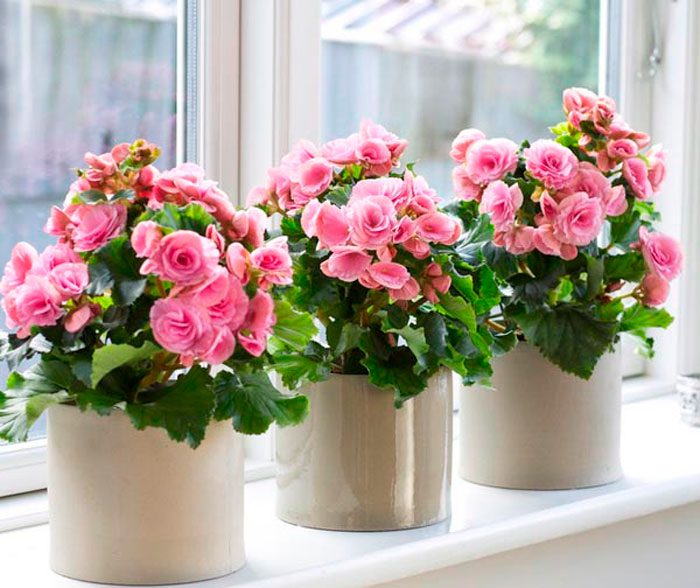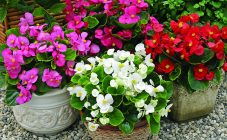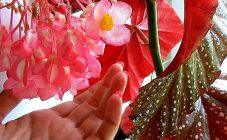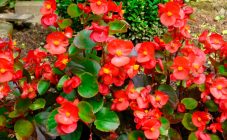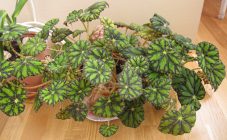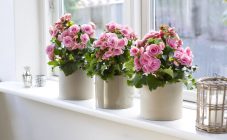Content:
Begonia is a common perennial ornamental flowering plant with asymmetrical leaves and lush flowers that can be grown both at home and outdoors. In the wild, it grows in hot tropical forests, high in the mountains. The flower got its name Begonia in 1687 in honor of the scientific researcher M. Begon. It grows in South America, India, Africa. And the begonia was discovered by a member of the scientific expedition C. Plumier in the Antilles.
Description of culture
Initially, only 6 types of begonias were discovered, but subsequently breeders constantly created hybrids and developed new varieties. To date, more than 1000 different types of begonias are known.
Today begonia is grown mainly for indoor decoration, often used in design as a climbing plant. Small but lush potted bushes of Elatior Baladin begonias (or as it is also called winter begonia) can often be found in flower shops. Such flowers look beautiful and dignified, no worse than an ordinary bouquet.
In addition, scientists noted that this flower, being indoors, has a positive effect in the fight against stress, improves mood, and enhances brain activity.
Plant characteristic
The plant itself can be tall, medium-sized and short.
Tall species can reach up to 25-37 cm, medium-sized ones - 15-18 cm, and undersized ones - 8-15 cm.
Depending on the variety, the plant can be upright, bushy or creeping. There is a variety of ever-flowering begonia, but it can be grown exclusively at home, since it requires constant heat.
It is customary to divide begonias into 3 main groups:
- Deciduous-decorative species are characterized by a large leaf shape with a solid edge and wide, variegated stripes. Plants of the same species can have medium-sized foliage with jagged edges or carved with a wide range of colors (pinkish, silvery, green).
- Bush begonias do not have a specific characteristic in appearance. Depending on the variety, the leaves can have very different shapes and colors, but the most common are large, bright green leaves. The stems are high enough. Flowers both large and small, pink and white shades prevail.
- There are a great many tuberous begonias, so they can be distinguished only by their stems and flowers. Tuberous stems are light pink or bright green, flowers are variegated and large (double, semi-double and ordinary). By itself, this species is considered undersized.
Tuberous begonias differ from the rest of the aboveground organs, the stems are much higher and stronger.Rhizomes and fibrous ones also have a difference, they have small villi on the roots and stems, they grow in bushes, so they are often planted in hanging baskets, where they look the most attractive.
Begonias are male and female. With the help of artificial pollination of flowers, you can subsequently get seeds of a certain type or hybrid. To do this, you need to have plants of different sexes. In the male plant, the flowers have 2 sepals, in contrast to the female (they have 3), and 2 filmy bracts. The pollen from the male flower is collected with a brush and the female flower is pollinated. After a while, a three-nested winged seed pod will ripen near the female flower, the seeds from which are used for germination.
Pollinating plants in the above way, you need to know that some types of double flowers do not have pollen and stamens.
In the natural environment, flowers are pollinated by insects, mainly bees.
Characteristics of species and varieties of crops
The most popular and common varieties of begonias:
- Begonia Elatior is a hybrid that has thick stems and large, smooth leaves. In plants with simple flowers, the leaves are serrated, with double ones - carved, resembling a spruce paw in appearance.
- Begonia Baladin grows as a bush, which is distinguished by a contrasting combination of dark green leaves and small bright flowers. Loves warmth and sunlight, does not tolerate low temperatures, is demanding on the soil. You need a nutritious and well-drained soil, as well as moderate watering.
- Begonia Pickles is a low bush that is literally covered with lush, large flowers. The color range is from pale yellow to bright red. Not whimsical in leaving. It can grow both in the sun and in partial shade. Resistant to diseases and parasites.
- Begonia Royal has large and very long (up to 30 cm) leaves of a rounded or oval shape with small serrations along the edges. They are painted in a variety of colors: brown, pink, violet, purple, green. The leaves are often light-colored. Such begonia has no flowers, but this is compensated by the unusual and very beautiful color of the foliage.
- Begonia Duck Red is a bush with beautiful, large, fragrant and lush flowers that resemble peonies. Flowers can be simple and fringed. The leaves are dark green, carved.
- Ampelous begonia is used more often to decorate walls and hedges. Has long, flowing stems. The flowers are bright, smooth, double and semi-double. The leaves are heart-shaped, covered with villi. One plant can contain both female and male flowers. This variety is self-pollinated.
Features of planting and caring for begonia Elatior
When planting begonia in open ground, you need to choose places on hills with good lighting.
Indoors begonia feels great. It is important not to over-water it and ensure good drainage. It is best grown on a windowsill.
In order for the culture to please the eye with a lush bouquet, pinching can be carried out - break off the side branches, leaving a length of 5 cm. Thus, new branches will grow, awakening from dormant buds.
Reproduction of begonias
Begonia can be propagated using seeds, cuttings and rooting of the apical shoots (leaves).
The seeds are harvested from the seed pod when it is ripe. They are grown in the ground.
Shoots (leaves) are cut with a sharp knife into triangular pieces, making sure that each has at least one vein. Then the cut pieces are placed in small cups with soil, covered with foil, sometimes sprayed with water.
You can take a large sheet with a good vein in the middle, make cuts across it, lay it on top of damp ground, cover with foil. It is recommended to press down the places near the incisions with stones. The container with the leaf is left in a warm and bright place, regularly sprayed with water. A month later, young shoots will appear, which dive and plant.
Cutting occurs as follows: the leaf is cut off and placed in a glass of water. When it gives roots, you can transplant it into the ground.
Diseases and pests
Diseases usually occur as a result of improper care:
- Leaves dry out - lack of moisture.
- Leaves grow small - feeding is required.
- Leaves wither - poorly ventilated room.
- Decay - excessive humidity in the room or watering.
- Unhealthy spots on the leaves are viral diseases. Not treated. The plant must be destroyed.
- Mold, rot and powdery mildew - treated with benomyl or fungicide.
Pests are destroyed with the help of special preparations (heterophos, decis, fufanon, actellik), soap solutions and garlic tinctures.
Begonia Elatior or any other plant variety is a great option for growing at home. The flower is undemanding to care for and multiplies easily; it is practically not affected by diseases and pests. Moreover, everything is so simple that even a beginner grower will be able to wait for abundant flowering in a few months.
